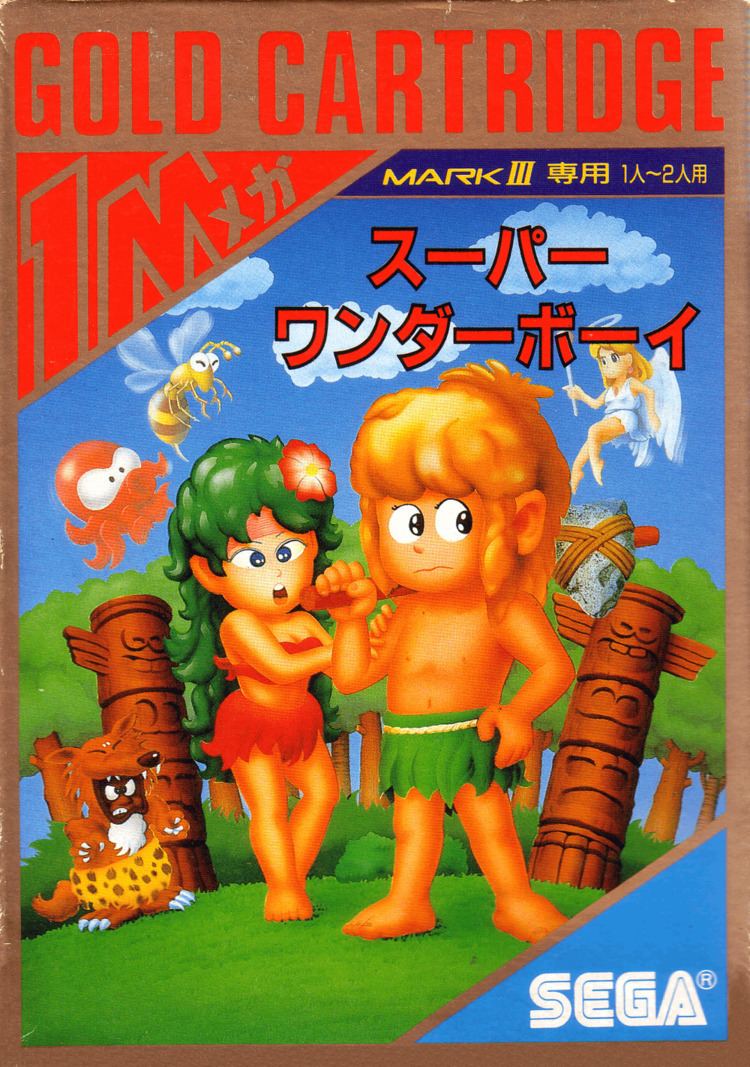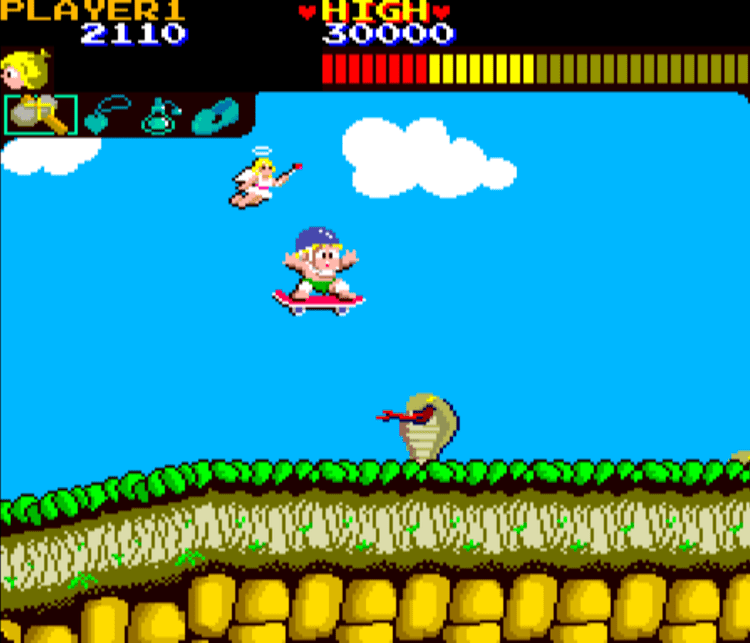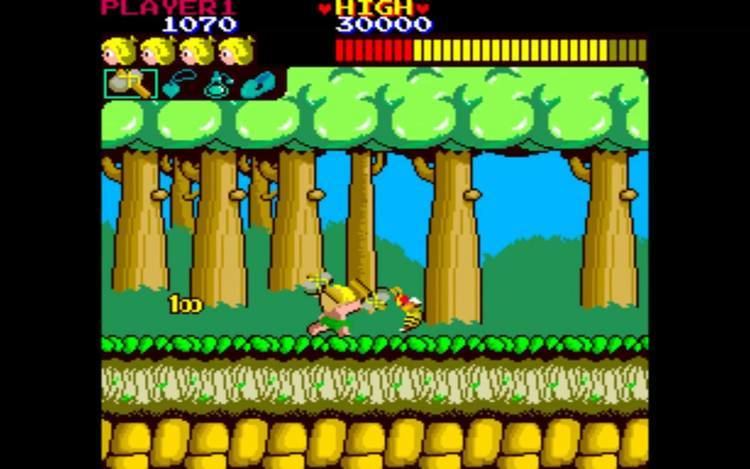6.8 /10 1 Votes
3/5 Aptoide Designer(s) Ryuichi Nishizawa Mode(s) Single player Initial release date 1986 Genre Platform game | 3.8/5 Classic Retro Games Director(s) Ryuichi Nishizawa Composer(s) Ryuichi Nishizawa Arcade system Sega System 1 Cabinet Video game arcade cabinet | |||||||||||||||||||||||||||||||||
 | ||||||||||||||||||||||||||||||||||
Display Raster, 256×224, horizontal orientation Platforms Arcade game, Master System, PlayStation 4, Wii, Game Gear, Commodore 64, ZX Spectrum, SG-1000, Amstrad CPC Developers Sega, Activision, Westone Bit Entertainment, Escape Publishers Sega, Activision, Hamster Corporation, The Hit Squad Similar Westone Bit Entertainment games, Platform games | ||||||||||||||||||||||||||||||||||
Wonder Boy (ワンダーボーイ, Wandā Bōi) is a 1986 platformer video game published by Sega and developed by Escape (now known as Westone Bit Entertainment).
Contents
- Gameplay
- SG 1000
- Master System and Game Gear
- ZX Spectrum Commodore 64 and Amstrad CPC
- Mobile phone port
- Wii Virtual Console
- Remake
- Clones
- Arcade hardware
- Arcade version
- Amstrad CPC version
- ZX Spectrum version
- Commodore 64 version
- Mobile version
- References

Originally designed for arcades, it was later ported to the SG-1000, Sega Mark III/Master System and Game Gear video game consoles by Sega, and to the ZX Spectrum, Commodore 64 and Amstrad CPC home computers by Activision. The game is also known as Super Wonder Boy (スーパーワンダーボーイ, Sūpā Wandā Bōi) for its Sega Mark III release in Japan and Revenge of Drancon for its Game Gear release in North America. A high definition remake of the game, titled Wonder Boy Returns, was developed by CFK and released on Steam on October 12, 2016.

It was the first in the long-running Wonder Boy series of games and was followed up by five sequels, Wonder Boy in Monster Land, Wonder Boy III: Monster Lair, Wonder Boy III: The Dragon's Trap, Wonder Boy in Monster World and Monster World IV. The game was also adapted by Hudson Soft as Adventure Island, which spawned its own series of games.
Gameplay

The titular Wonder Boy (later named Tom-Tom in the Master System version, known simply as "Boy" in the Japanese versions) is a tribal islander-like boy whose girlfriend Tina (renamed Tanya in the Master System version) has been captured by the dark King (known as Drancon in the Game Gear version). The player must guide the Wonder Boy through seven "areas", each consisting of four "rounds". The levels are made up of forests, hills, oceans, caves, ice palaces and occasionally mountains lands. The levels always run from left-to-right, with some vertical movement.

The boy can arm himself with a stone hatchet, which he can throw at oncoming foes, a skateboard with which he can rush through the levels and survive one attack by an enemy, and temporary protection by an angel which allows him to destroy foes by simply running into them. All of the aforementioned power-ups are obtained by breaking open eggs. These eggs can also contain unpleasant surprises – curses which cause him to lose vitality more quickly than usual, and poisonous mushrooms which reduce the boy's vitality in one go. "Bad eggs" can be easily spotted, as they are covered in red spots, whereas "good eggs" that contain hatchets, skateboards and angels are plain white. The player must remain aware of the vitality meter, which constantly runs down at a steady pace and can only be refilled by collecting fruit throughout the level. There is also one doll to collect in each level, which doubles the bonus points awarded at the end of the level. If all 28 dolls are collected, then an eighth area will be unlocked.

At the end of every "area" (thus every four "rounds"), the boy will encounter an incarnation of the chief antagonist as a boss character. Once defeated, the mighty lord's mask flies off and transforms into an item such as a tea cup or a piece of fruit for the boy to collect. The evil witch doctor then subsequently makes his escape.
A two-player alternating mode is available where each player takes turn whenever the other one loses a life.
SG-1000
The first home version of Wonder Boy was released exclusively in Japan for the SG-1000 (Sega's first video game console) during the same year the arcade version was released. The game was released in a "My Card" format, which required the "Card Catcher" peripheral. Because of the severe hardware differences, the game was remade completely for the SG-1000 with an all new set of stages. Certain enemies and stages were also omitted, such as the skateboard.
Master System and Game Gear
The version of Wonder Boy for the Master System and Game Gear was a direct port of the arcade title, with some minor reductions to accommodate the more limited hardware. In Japan, the Sega Mark III version was entitled Super Wonder Boy to differentiate it from the previous port, although the overseas releases dropped the word "Super" from the title. The Game Gear port in the United States was entitled Revenge of Drancon.
The graphics were lifted straight from the arcade version, but the HUD was restricted to a simple vitality bar – the score and number of lives were displayed prior to starting the level. The sound was modified slightly to adapt it to the more limited audio hardware. The graphics were brighter. The controls were modified slightly to make it possible to only perform a high jump when the run button was pressed, whereas it was possible in the arcade version to perform one simply by being in motion when jump was pressed.
However, the most important aspect that differentiated it from its arcade counterpart was the addition of "areas". Wonder Boy for the Master System and Game Gear had nine areas; this included all seven areas from the arcade original + two new areas created specifically for this version. The new areas featured unique level design different than the rest of the game. These two areas were dubbed as the fourth area and eighth area in the game. This resulted in a modification on the numbering for the areas lifted from the arcade original (for example, what was the fourth area on the arcade version became the fifth area on the SMS/GG version).
As with the arcade version, collecting all dolls in the game would reveal an extra "area" which, in this case, would be the tenth area.
ZX Spectrum, Commodore 64 and Amstrad CPC
The license to produce the home computer versions of Wonder Boy was awarded to Activision, who produced versions of the game for the ZX Spectrum, Commodore 64 and Amstrad CPC in 1987. The game was true in spirit to the original, although the levels beyond level 4 differed to allow for the necessary multi-load system. The first round of each area was always a forest, the second an ocean, the third a cave and the fourth a forest at nighttime (the C64 had round 1 at night time and round 4 during the day). This was not the case in the console and arcade versions, in which the areas provided more variation (although based on these same four themes). Interestingly, the Amstrad CPC version contained the graphics used in the C64 conversion, but the sound from the Spectrum conversion.
Some Spectrum versions were afflicted with a bug that prevented the game from preloading all four levels in 128K mode – the fourth level's graphics would not load correctly, and it would be impossible for the player to move before the game crashed and the computer rebooted within around three seconds. As a result, 128K owners were forced to boot into 48K mode to run the game, and did not enjoy the benefit of having all levels preloaded as was designed. Under 48K mode, however, the 128K music still worked.
Mobile phone port
In 2004, Sega released a pixel-perfect conversion of the game designed for mobile phones.
Wii Virtual Console
On March 31, 2008, Wonder Boy was made available for play on the Nintendo Wii Virtual Console in North America. Japan & Europe got the game a week later. The game is available for 500 Wii points, and is an emulation of the Sega Master System version.
Remake
A high-definition remake of the game, titled Wonder Boy Returns, was developed by CFK and released on Steam on October 12, 2016.
Clones
Escape/Westone had a licensing arrangement whereby they owned the rights to the game, but Sega retained rights to the main characters, bosses, and names. Because of this they teamed up with Hudson Soft to produce a conversion of the game for the NES, under a new license. To get around the licensing issue, Hudson Soft simply had the graphics of the main character and the title changed. The result was Adventure Island, which instead of featuring the generic boy character, inserted a caricature of Takahashi Meijin (known as Master Higgins in English games), who bore a striking resemblance to the original character design except for the adjusted hair color, trademark hat and characteristic underbite. The game was, however, Wonder Boy in all but name. In this arrangement, once again, Hudson Soft retained the rights to the character and name, allowing them to continue to produce future games using the Adventure Island name and characters. These sequels are not based on the Wonder Boy sequels but instead continue the style of gameplay from the original Wonder Boy.
Hudson released Champion Takahashi's Adventure Island for the MSX. This version featured Master Higgins as the main character but retained the music of Wonder Boy, unlike the NES Adventure Island which had a completely different soundtrack.
Escape/Westone repeated the same kind of task by converting Sega's 1991 beat 'em up arcade Riot City, into Hudson Soft's 1992 TurboGrafx-CD title Riot Zone.
Through their 2012 absorption of Hudson Soft, Konami currently owns the rights to the Adventure Island series.
Arcade hardware
The game ran on Sega's proprietary System 1 hardware, based on a Z80 processor running at 4 MHz. Audio was provided by two 2 MHz SN76496 chips with a 4 MHz Z80 co-processor. The graphics were provided by a raster video unit at a resolution of 256 x 224.
The game required a cabinet that provided a two-axis joystick and three input buttons – one to act a start button, two as gameplay buttons.
Arcade version
Upon release, the arcade game was critically acclaimed. In the July 1986 issue of Computer and Video Games, the game was lauded by reviewer Clare Edgeley for the detailed, bright, colorful graphics and simple addictive gameplay, whilst some criticism was leveled towards the lack of variety. She also stated it reminds her of Super Mario Bros. though "not as complicated but just as playable." Contemporary writers now note that both games share a common ancestor in Pac-Land.
Wonder Boy was a commercial success in arcades. It appeared at number-two on Euromax's nationwide UK arcade chart in 1987, just below Capcom's 1942 at number-one.
Amstrad CPC version
Amstrad Action awarded the Amstrad CPC version of the game 68% on its original release in 1987, and 62% on its re-release three years later. Computing With the Amstrad awarded the game 88% on its original release.
ZX Spectrum version
CRASH remained unconvinced, citing technical shortcomings, including poor character-based scrolling, considerable slowdown, and confusion induced by the monochrome display. On its re-release, while quoting the aforementioned problems, the reviewer was willing to overlook them, highlighting the quality of the sprites and the fun offered by the game, and offering it 69%.
Sinclair User was the most enthusiastic about the game, offering it 8 out of 10 on its original release, and 72% on its re-release. Your Sinclair offered 7 out of 10 on its original release and 67% on its re-release.
Commodore 64 version
The C64 version shares the same graphics as the Amstrad CPC version, unlike the ZX Spectrum and Amstrad versions however the game featured smooth horizontal scrolling. Zzap rated the game 52% criticising the poor sound and labelling the actual arcade game as 'ordinary'.
Mobile version
IGN awarded it 7.1 out of 10, praising its accuracy to the arcade original.
